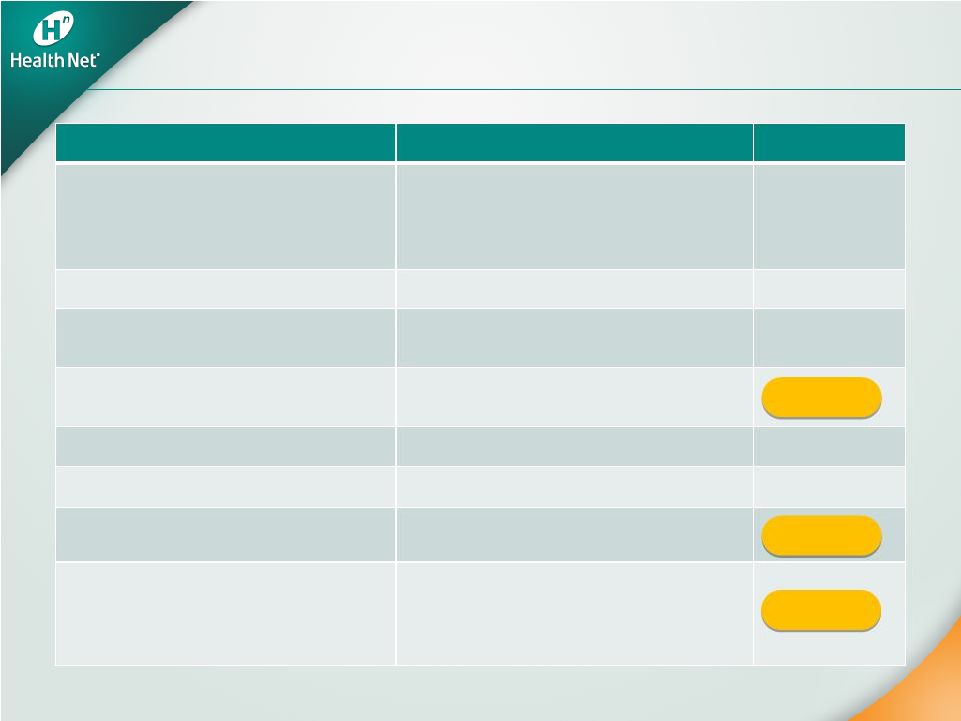 Health Net, Inc. Health Net, Inc. 2011 Investor Day 2011 Investor Day February 17, 2011 Exhibit 99.1 |
 Cautionary Statement 2 All statements in this presentation, other than statements of historical information provided herein, including but not limited to the guidance for future periods included herein and the assumptions and underlying such projections, may be deemed to be forward-looking statements and as such are subject to a number of risks and uncertainties. These statements are based on management’s analysis, judgment, belief and expectation only as of the date hereof, and are subject to uncertainty and changes in circumstances. Without limiting the foregoing, the guidance as to expected future period results and statements including the words “believes,” “anticipates,” “plans,” “expects,” “may,” “should,” “could,” “estimate,” “intend” and other similar expressions are intended to identify forward-looking statements. Actual results could differ materially due to, among other things, health care reform, including the ultimate impact of the Affordable Care Act, which could materially adversely affect the company’s financial condition, results of operations and cash flows through, among other things, reduced revenues, new taxes, expanded liability, and increased costs (including medical, administrative, technology or other costs), or require changes to the ways in which the company does business; rising health care costs; continued slow economic growth or a further decline in the economy; negative prior period claims reserve developments; trends in medical care ratios; membership declines; unexpected utilization patterns or unexpectedly severe or widespread illnesses; rate cuts affecting the company’s Medicare or Medicaid businesses; costs, fees and expenses related to the post-closing administrative services provided under the administrative services agreements entered into in connection with the sale of the company’s Northeast business; potential termination of the administrative services agreements by the service recipients should the company breach such agreements or fail to perform all or a material part of the services required thereunder; any liabilities of the Northeast business that were incurred prior to the closing of its sale as well as those liabilities incurred through the winding-up and running-out period of the Northeast business; litigation costs; regulatory issues with agencies such as the California Department of Managed Health Care, the Centers for Medicare and Medicaid Services and state departments of insurance, including the continued suspension of the marketing of and enrollment into the company’s Medicare products for a significant period of time, which could have a material adverse impact on the company’s Medicare business; operational issues; investment portfolio impairment charges; volatility in the financial markets; and general business and market conditions. Additional factors that could cause actual results to differ materially from those reflected in the forward-looking statements include, but are not limited to, the risks discussed in the “Risk Factors” section included within the company's most recent Annual Report on Form 10-K and subsequent Quarterly Reports on Form 10-Q filed with the Securities and Exchange Commission (“SEC”), and the risks discussed in the company’s other filings with the SEC. Readers are cautioned not to place undue reliance on these forward-looking statements. The company undertakes no obligation to publicly revise its guidance, the assessment of the underlying assumptions or any of its forward-looking statements to reflect events or circumstances that arise after the date of this presentation. |
 3 Non-GAAP Measures These presentations include quarterly and full year income statement measurements that are not calculated and presented in accordance with Generally Accepted Accounting Principles. Audience participants should refer to the financial table included in the Appendix to the presentations, which also is available on the company’s website at www.healthnet.com, and reconciles certain non-GAAP financial information to GAAP financial information. |
 4 Agenda 8.30 a.m. – 9.00 a.m. Welcoming Remarks Angie McCabe, Vice President, Investor Relations Introduction and Strategic Overview Jay Gellert, President and Chief Executive Officer 9.00 a.m. – 10.00 a.m. Commercial Growth and Margin Expansion Steven Sell, President, Western Region Health Plan Underwriting and Actuarial Review Richard Hall, FSA, MAAA, Chief Actuarial Officer 10.00 a.m. – 10.15 a.m. BREAK 10.15 a.m. – 11.15 a.m. Medicare and State Programs Scott Kelly, Chief Government Programs Officer Federal Services Steven Tough, President, Government Programs 11.15 a.m. – 12.15 p.m. Operations Review Juanell Hefner, Chief Customer Services Officer Jay Gellert, President and Chief Executive Officer Financial Review Joseph Capezza, Chief Financial Officer 12.15 p.m. – 12.30 p.m. Closing Remarks Jay Gellert, President and Chief Executive Officer Note: Presentation times subject to change. |
 Health Net, Inc. Health Net, Inc. 2011 Investor Day 2011 Investor Day |
 Strategic Overview Strategic Overview Jay Gellert President and Chief Executive Officer |
 7 Emerging Environment Emerging Environment • Economy is driving change • Federal and state budget pressures will affect health care • Future implementation of Affordable Care Act remains to be defined • Diverse book of businesses where value differentiation is key |
 8 Our Strategy To Date Our Strategy To Date • Build value-based products • Diverse book of businesses – Risk and fee – Medicaid, Medicare, TRICARE and commercial • Deemphasize volatile segments – e.g., individual • Invest in G&A efficiencies • Dispose of weak assets • Strengthen balance sheet |
 9 2011 Key Milestones 2011 Key Milestones • Stronger risk membership • TRICARE to ASO • Maintain low G&A ratio • Expand commercial margins • Continue to add new products • Use cash for benefit of shareholders |
 10 Future Opportunities Future Opportunities • Broadening commercial business • Rebound in Medicare • Medicaid expansion • Department of Defense options • G&A leverage • Balance sheet flexibility |
 Health Net, Inc. Health Net, Inc. 2011 Investor Day 2011 Investor Day |
 Commercial Growth Commercial Growth and Margin Expansion and Margin Expansion Steven Sell President, Western Region Health Plan |
 Commercial: Positioned for Growth Commercial: Positioned for Growth • Economy is driving HMO demand • Health Net has a strong and sustainable HMO market position • Tailored products and networks drive growth • Margin expansion opportunities 13 |
 Economy Driving Demand • Market research shows customers looking for: – Affordable solutions – Convenient access – Clear and simple choices • Consumer-directed health plans (CDHP) show some stress – Among highest premium increases • HMO value proposition: “back to the future” – Affordable premiums – Primary care leadership – Comprehensive benefits / low copays 14 |
 Health Care Reform Health Care Reform Favors Managed Care Favors Managed Care • PPO benefit advantages being reduced – Elimination of annual and lifetime limits in 2011 – Zero copay preventive care in 2011 – Deductible caps coming in 2014 • Traditional ASO vs. risk – Risk still best value in California – even for large, national employers • Providers will play more prominent role – Incentives in law to create managed care infrastructure (e.g., accountable care organizations) – Seeking to balance Medicare and Medicaid revenue pressures with commercial growth 15 |
 16 Health Net: Health Net: Strong HMO Market Share Strong HMO Market Share • Dominant network HMO player in California market • Steady market share growth over the last four years • Small group market share increase: 31 percent to 41 percent in the past four years Source: Data from Department of Managed Health Care and excludes Kaiser and all PPO data. Percent share reflects percent share of top statewide competitors. Small Group Network Model HMO Market Share |
 The Power of Capitation The Power of Capitation • Focuses providers on cost management and commercial growth • Stabilizes trends and makes them more predictable • Reduces administrative costs as claims processing is delegated Source: Based on Health Net internal data as of December 31, 2010. More than 80 percent of HNCA’s commercial membership is enrolled in capitated medical groups More than 30 percent of HNCA’s commercial capitated membership is enrolled in tailored network plans 17 |
 • Drives volume to “high value” providers (low cost/high quality) • Employer premiums up to 30 percent lower • Offers comprehensive coverage • Increased interest in new geographies and segments Strong and Evolving Tailored Networks Strong and Evolving Tailored Networks 18 Source: Based on Health Net internal data HNT Tailored Network Membership |
 How Tailored Network Products Work How Tailored Network Products Work • Foundation is traditional HMO capitated networks – Broad physician panel in group or IPA – Includes wide range of institutional options – Comprehensive benefits with low copays • Tailored networks – Include cost-effective provider groups • Stronger partnerships built on higher volume and joint marketing – Includes select institutional options that optimize cost and quality • Substantial savings accrue to customer by excluding high cost, geographically remote institutions – Comprehensive benefits with low copays 19 |
 Growth with Margin Expansion Growth with Margin Expansion • Strategically changing mix – Segment: small group and mid-market – Product: tailored network products – Geographic: Southern California vs. Northern California • Targeted sales and improved retention • Disciplined underwriting and pricing • Continued focus on health care cost containment – Stronger provider partnerships 20 |
 Well Positioned for Growth Well Positioned for Growth • Growing market share in California • Product solutions meeting market demand – Opportunities to apply solutions to Arizona and Oregon • Margin expansion driven by: – Improved product and segment mix – Consistent underwriting and pricing discipline • Provider-payor relationships evolving 21 |
 Health Net, Inc. Health Net, Inc. 2011 Investor Day 2011 Investor Day |
 Underwriting and Underwriting and Actuarial Review Actuarial Review Richard T. Hall, FSA, MAAA Chief Actuarial Officer |
 A New Commercial Environment A New Commercial Environment • Underwriting and pricing discipline • Return to HMO plans / pressure on less managed plans • Regulatory pressure and individual market issues • Providers seeking commercial share to offset growing cost shift • 2011 pricing assumptions and outlook 24 |
 Underwriting and Pricing Discipline Underwriting and Pricing Discipline • Rigorous planning process – Analyze membership – Identify best gross margin opportunities – Sensitivity analyses • Targeted geographies, segments and products where we have a clear competitive advantage • Enhanced sales and underwriting process to optimize profitable membership growth 25 |
 26 2010 Results Affirm Strategy 2010 Results Affirm Strategy • Targeted pricing to improve mix in large group – MCR of renewing groups in California was better than canceled groups by 100 basis points in 2010 – Implemented processes to achieve an improved retention rate • From 81 percent in 2010 to 91 percent in January 2011 • Industry standard is approximately 82 percent • Membership and margin opportunities in small group segment – MCR of renewing groups was better than canceled groups by 210 basis points in 2010 |
 Return to HMO Return to HMO • Demonstrable premium differential for equivalent benefits • ASO vs. risk: California experience • Growing out-of-pocket limits not sustainable for members and providers • Health care reform and economy limit ability to shift costs to employees 27 |
 Premium Differentials Premium Differentials • Traditional HMO vs. PPO – HMO is 30 percent less – Example: Los Angeles County – HMO – $30 copay / $2,000 out-of-pocket maximum – PPO – $30 copay in-network / $500 deductible / $2,000 out-of-pocket maximum • Tailored network 10 percent to 25 percent less than traditional HMO – Targeted to specific, cost-effective provider groups – Better performing MCR than traditional HMO – Less expensive than Kaiser in many cases 28 |
 Regulatory Pressure Regulatory Pressure and Individual Market Issues and Individual Market Issues • Cautious approach to individual market • Emerging regulatory environment • External focus on rate increases • Preparing for implementation of exchanges 29 |
 Changing the Provider-Payor Changing the Provider-Payor Paradigm Paradigm 30 • Market driving to integrated approach • Health Net offers value to providers – People and relationships – True local presence – Business model – All segment focus – Providers seeking to retain and build commercial market share • Joint efforts in cost and quality management |
 2011 Commercial Pricing Assumptions 2011 Commercial Pricing Assumptions • 2010 physician and institutional utilization moderated from 2009 • 2011 pricing assumes upward pressure on physician and institutional utilization • 2011 unit cost trends expected to be lower than 2010 trends • 2011 pharmacy cost increases expected to be similar to 2010 31 |
 Beyond 2011 Beyond 2011 • Sectoral – not cyclical – changes in market – Driven by health care reform and economy • Trends remain moderate by historical standards – Growing impact of tailored network plans and focus on affordability • Steadily growing influence of capitated systems • Institutional providers seek new partnerships to achieve cost effectiveness and enhance competitive position 32 |
 Health Net, Inc. Health Net, Inc. 2011 Investor Day 2011 Investor Day |
 Medicare and Medicare and State Programs State Programs Scott Kelly Chief Government Programs Officer |
 Solid Medicare Outlook Solid Medicare Outlook • Balance Medicare Advantage revenue, benefits/premiums and costs to ensure: – Stable margins – Continued competitive product offerings • Continued focus on capitated networks • Enhance strategic provider partnerships in coordination with commercial business • Position Part D book for 2012 growth • Strengthening operations and controls to respond to CMS sanction issues 35 |
 Medicare Advantage: 2011 Medicare Advantage: 2011 • Building from solid 2010 • January enrollment results better than initial expectations • Total revenues PMPM expected to be up 1.5 percent – Member premiums up 3.4 percent PMPM • Expect MCR to be flat year-over-year – Health care cost stability – Benefit changes: hospital and outpatient copays, deductibles • Preparing for 2012 bidding process 36 |
 Medicare Part D Medicare Part D • 2010 margins maintained by favorable prescription drug performance and unit costs • 2011 enrollment expected to decline 14 percent to 16 percent compared with 2010 • Guiding to breakeven 2011 performance due to effects of CMS sanctions 37 |
 CMS Sanctions CMS Sanctions What Happened? • CMS identified issues in HNT’s Part D program What’s Next? • Corrective actions are in process • Plan to review corrective actions with CMS in second quarter of 2011 • Broader compliance initiatives in place to ensure appropriate administration of government business overall 38 |
 Medicare Advantage Medicare Advantage Provider Networks Provider Networks • Nearly 40 percent of health care costs capitated – Over 50 percent in California market – More than 135 provider groups in 21 counties • Mostly percent of premium contracts • Collaboration with organized health systems to reduce total costs to achieve margin stability • Working closely on risk adjuster capture and accuracy with key groups 39 |
 State Health Programs State Health Programs • Potential for growth – Health care reform – Seniors and Persons with Disabilities (SPD) – New counties 40 Total State Program Revenues |
 Medi-Cal Position Medi-Cal Position • 753,700 members at year-end 2010, an increase of 7 percent year-over-year • Second largest Medi-Cal plan in California – 58 percent of membership in Los Angeles County – 34 percent in Central Valley • Market share stable at over 24 percent • Remain the highest ranking Medi-Cal HMO plan in California by U.S. News and World Report 41 |
 2011 Medi-Cal Outlook 2011 Medi-Cal Outlook • Expect 6 percent membership growth • Maintain stable financial performance – Rate environment understood • Key strategic position for health care reform • SPD program offers potential significant growth opportunity 42 |
 Healthy Families Healthy Families • 145,800 members at year-end 2010, a decrease of 4.7 percent year-over-year – Market share remains flat as general statewide enrollment declines • 2011 program outlook – Expect 6 percent membership decline – Margin stable 43 |
 State Programs Provider Networks State Programs Provider Networks • 80 percent of State Programs enrollment linked to capitated provider groups • Over 45 percent of health care costs under capitated arrangements – 75 percent of physician costs – 27 percent of hospital costs • Noncapitated hospital rates on Medicaid fee schedule 44 |
 Stable Government Programs Stable Government Programs • Margin stability in long-standing Medicare Advantage network-model markets – Predictable cost structure – Solid membership retention • Medi-Cal: prepare for growth of SPDs and health care reform expansion • 2011 focus on strong operational and regulatory performance and preparations for 2012 open enrollment 45 |
 Health Net, Inc. Health Net, Inc. 2011 Investor Day 2011 Investor Day |
 Federal Services Federal Services Steve Tough President, Government Programs |
 Government Contracts Highlights Government Contracts Highlights • New TRICARE contract begins April 1, 2011 • ASO, fee-based, five-year contract • Improves company balance between risk and fee-based businesses • Opens door to new opportunities as Department of Defense (DoD) faces budget pressures 48 |
 2011: A Transition Year 2011: A Transition Year • Contract financial structure changes from cost plus risk sharing to cost plus incentive – New contract accounted for as ASO • 2011 includes ¼ year of current contract, ¾ year of new contract, plus current contract phase-out revenues and expenses – Expect 2011 pretax contribution from Government Contracts to decline by approximately $25 million from 2010 49 |
 Current Contract to New Contract: Current Contract to New Contract: Incentive and Risk Changes Incentive and Risk Changes • Fixed-dollar underwriting fee • Administrative efficiencies under a fixed administrative budget • Underwriting incentives – network discount, network usage and national cost trend – National cost trend incentive based on our PMPM health care cost trend for contractor enrollees vs. national health care expenditure per capita trend • Performance guarantees and incentives • Award fee calculated twice yearly (Q2 and Q4) under new contract vs. quarterly under current contract 50 |
 Growth Opportunities Growth Opportunities • Military & Family Life Consultant (MFLC) program success – Apply MFLC model to other federal customers • DoD efforts under way – budget challenges create potential opportunities – Extend services to National Guard and Reservists – Managed solutions for TRICARE for Life • Behavioral health outreach requirements continue to grow as needs escalate • Veterans Affairs (VA) seeks expansion of its rural behavioral health support program • Existing services and products have application to other government programs 51 |
 Key Takeaways Key Takeaways • Well positioned to continue leadership role with DoD and VA • Transition to new contract on track • Wide range of behavioral health opportunities – Build on MFLC success • Continue to expand VA and state administrative footprint 52 |
 Health Net, Inc. Health Net, Inc. 2011 Investor Day 2011 Investor Day |
 Operations Review Operations Review Jay Gellert President and Chief Executive Officer Juanell Hefner Chief Customer Services Officer |
 Operations Strategy Operations Strategy and Stranded Costs and Stranded Costs • Announced a three-year effort to restructure operations in 2007 • Built around these goals: Optimize outsourcing Eliminate operations and system inefficiencies Enhance scalability Improve competitive platform • Reduce “stranded costs” associated with sale of Northeast and new TRICARE contract • Goal: support sustained long-term margin improvement 55 |
 G&A Expense Reductions G&A Expense Reductions • Invested $145 million after tax in G&A expense reduction activities over the last three years (i.e., severance, asset impairment, etc.) • Without these investments, Western Region G&A would have been higher by approximately $100 million pretax in 2010 • Achieved additional savings in the Northeast and Government Contracts division • Targeting an additional $100 million in pretax savings in 2011 and 2012 to compensate for Northeast stranded costs and TRICARE gap – Savings primarily from headcount reductions 56 |
 Northeast Wind-down and Overhead Reductions Northeast Wind-down and Overhead Reductions Operations Strategy Operations Strategy • Infrastructure outsourcing • Application outsourcing • Business process outsourcing • Management restructuring • Operational efficiencies • Vendor management • Wind-down of NE operations • Finance outsourcing • Additional operations outsourcing • Managerial restructuring • Arizona systems migration • Print and fulfillment • Real estate cost improvements • Operational efficiencies Areas of Savings Areas of Savings 57 |
 Improved Operations Improved Operations • Operations are better integrated – More consistent procedures – Greater flexibility to use staff and resources efficiently – Improved performance management • Have realized benefits from business process outsourcing of noncustomer facing functions – Scalability – Cost improvements – High levels of quality and performance 58 |
 Improved Operational Performance Improved Operational Performance • Claims – Accuracy – Claims turnaround time • Call center performance – First call resolution • Enrollment and eligibility performance – Enrollment accuracy – Enrollment timeliness – Eligibility accuracy All key operational metrics have improved or All key operational metrics have improved or stabilized over the past three years stabilized over the past three years 59 |
 Positioned for the Future • Improved speed to market – Outsourcing allows for rapid capacity ramp-up to support growth – Can leverage vendor expertise and resources to create new and expanded operational capabilities • Technology infrastructure now positioned to support future performance and growth – New equipment and software upgrades – Network upgrades – Investment in strategic applications 60 |
 Key Takeaways Key Takeaways • Further G&A reductions will contribute to margin improvement • Operations positioned to support long-term growth • G&A positioned to offset minimum MCR requirements • Eliminating stranded costs associated with Northeast business and new TRICARE contract • Improved operations enhance capacity to deliver new products and services 61 |
 Health Net, Inc. Health Net, Inc. 2011 Investor Day 2011 Investor Day |
 Financial Review Financial Review Joseph C. Capezza Chief Financial Officer |
 64 Original Guidance Actual Year-end membership • Commercial: -1% to -2% • Medicaid: +5% to +6% • Medicare Advantage: -2% to -3% • PDP: +1% to +2% -4.4% +5.1% -2.2% -7.2% Consolidated revenues $13 billion to $13.5 billion $13.6 billion Commercial premium yields (a) ~ 8.3% to 8.8% (Western Region 2009: ~$316 PMPM) 7.9% Commercial health care cost trends (a) ~ 20-40 bps < premium yields (Western Region 2009: ~$274 PMPM) Government Contracts ratio ~ 94.5% to 95% 94.7% G&A Expense ratio ~ 8.8% to 9% 8.9% Weighted-average fully diluted shares outstanding 103 million to 104 million GAAP EPS Combined Western Region Operations and Government Contracts EPS $1.92 to $2.02 $2.32 to $2.42 $2.06 (a) Commercial premium yields and commercial health care cost comparisons are on a same-store basis for the company’s Western Region Operations only for both 2009 and 2010. 80 bps 80 bps 99.2 M 99.2 M $2.60 $2.60 2010 Results 2010 Results |
 65 A Solid 2010 Sets Stage for 2011 A Solid 2010 Sets Stage for 2011 • Strong year: met or exceeded key commitments • Commercial margin expansion – 2010 gross margin increased 13 percent to $47 per member per month (PMPM) • Commercial enrollment stabilized in the second half of 2010 • Strong cash: operating cash flow of $271 million, or 1.3 times net income • Repurchased 9 percent of 2009 shares outstanding • Further margin improvement opportunities |
 Stronger Balance Sheet Stronger Balance Sheet 66 2010 2009 Current ratio 1.70 1.68 Adjusted days claims payable * 57.2 54.2 Debt-to-total capital ratio 19% 26% Tangible net equity per share $11 $10 Risk-based capital >400% >400% *See Appendix for a reconciliation of this metric to the comparable GAAP financial measure |
 Northeast Transaction Net Cash Northeast Transaction Net Cash 67 2009 $377 million 2010 $63 million 2011 $80 million to $100 million Total $520 million to $540 million Original Guidance $490 million to $610 million |
 68 2011 Earnings Guidance 2011 Earnings Guidance Year-end membership (a) • Medicaid: +6% to +7% • Medicare Advantage (d) : -15% to -17% • Total Western Region Operations medical membership: +2% to +3% • PDP (d) : -14% to -16% Consolidated revenues (b)(d) $12.0 to $12.5 billion Commercial premium yields (a) ~ 7.8% to 8.3% Commercial health care cost trends (a) G&A expense ratio (a) ~ 8.7% to 8.9% Weighted-average fully diluted shares outstanding (c) 96 million to 97 million GAAP EPS (c)(d) Combined Western Region Operations and Government Contracts segments EPS (c)(d) At least $2.05 Commercial: +1% to +2% Commercial: +1% to +2% ~ ~ 40 40 to to 60 60 bps bps < < Premium Premium Yields Yields (a) For the company’s Western Region Operations segment (b) For the combined Western Region Operations and Government Contracts segments (c) The company’s guidance does not include the impact of share repurchases other than to counter dilution. (d) Includes the impact of the CMS sanctions previously announced on November 19, 2010 At least $2.75 At least $2.75 |
 69 2011 Cash at Parent 2011 Cash at Parent Beginning cash (12/31/10) $204 Sources of cash Net cash flow from subsidiaries NE proceeds $225 - $235 $80 - $100 Uses of cash Share repurchases through 1/31/11 Other corporate uses $34 ~$85 Ending cash* (12/31/11) ~$390 - $420 *Excludes the impact of any future share repurchases $ in millions |
 70 HNT: On Track HNT: On Track • Continued commercial gross margin expansion • Commercial membership growth • Seamless transition to new TRICARE contract • Continued strong cash flow performance – Opportunities for further capital deployment |
 Appendix Appendix |
 Disclosures Regarding Disclosures Regarding Non-GAAP Financial Information Non-GAAP Financial Information 72 Q4 2010 Q3 2010 Q4 2009 FY 2010 FY 2009 (1)Reserve for Claims and Other Settlements $942.0 $904.4 $951.7 $942.0 $951.7 Less: Reserve for Claims and Other Settlements for Divested Businesses - - - - - Less: Capitation Payable, Provider and Other Claim Settlements and Medicare Part D (108.7) (130.0) (162.8) (108.7) (162.8) (2)Reserve for Claims and Other Settlements - Adjusted $833.3 $774.4 $788.9 $833.3 $788.9 (3)Health Plan Services Cost $2,100.0 $2,134.7 $2,557.1 $8,609.1 $10,732.0 Less: Health Plan Services Cost for Divested Businesses - - (460.7) - (2,123.0) Less: Capitation Payable, Provider and Other Claim Settlements and Medicare Part D (762.6) (804.4) (818.4) (3,291.1) (3,296.0) (4)Health Plan Services Cost - Adjusted $1,337.4 $1,330.3 $1,278.0 $5,318.0 $5,313.0 (5)Number of Days in Period 92 92 92 365 365 = (1) / (3) * (5) Days Claims Payable - (using end of period reserve amount) 41.3 39.0 34.2 39.9 32.4 = (2) / (4) * (5) Days Claims Payable - Adjusted (using end of period reserve amount) 57.3 53.6 56.8 57.2 54.2 Management believes that adjusted days claims payable (adjusted for divested businesses, capitation, provider and other claim settlements and Medicare Part D), a non-GAAP financial measure, provides useful information to investors because the adjusted days claims payable calculation excludes amounts related to divested businesses and health care costs for which no or minimal reserves are maintained. Therefore, management believes that adjusted days claims payable may present a more accurate reflection of days claims payable calculated from claims-based reserves than does GAAP days claims payable, which includes such costs. This non-GAAP financial information should be considered in addition to, not as a substitute for, financial information prepared in accordance with GAAP. The following table provides a reconciliation of the differences between adjusted days claims payable and days claims payable, the most directly comparable GAAP financial measure. You are encouraged to evaluate these adjustments and the reasons we consider them appropriate for supplemental analysis. In evaluating the adjusted amounts, you should be aware that we have incurred expenses that are the same as or similar to some of the adjustments in the current presentation and we may incur them again in the future. Our presentation of the adjusted amounts should not be construed as an inference that our future results will be unaffected by unusual or non-recurring items. $ in millions |
 Health Net, Inc. Health Net, Inc. 2011 Investor Day 2011 Investor Day |
 Closing Remarks Closing Remarks Jay Gellert President and Chief Executive Officer |
 75 HNT: Building Shareholder Value HNT: Building Shareholder Value • Strategic response to changing environment • Diverse book of stable businesses • Opportunities for growth and further gross margin and G&A improvements • Financial flexibility |
 Health Net, Inc. Health Net, Inc. 2011 Investor Day 2011 Investor Day |